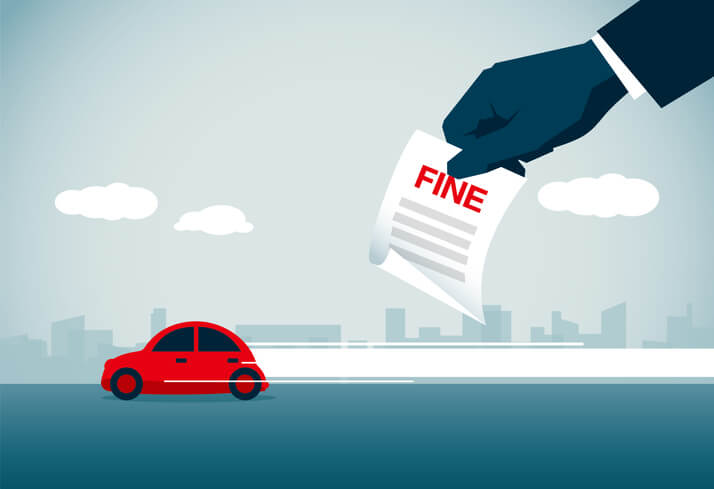Running a red light in California is not only dangerous—it’s expensive. Many drivers think it’s a $100 ticket, but after mandatory state surcharges and county fees, the real cost usually lands around $490–$550. Add potential insurance increases and a DMV point, and the impact can linger for years. The good news: eligible drivers can complete DMV-approved traffic school to keep the violation off their public record and protect their premiums.

California Red Light Ticket Cost Breakdown
Penalties are defined under California Vehicle Code § 21453. Here’s how the costs typically stack up:
| Item | Typical Amount |
|---|---|
| Base fine: illegal right on red | $35 |
| Base fine: failing to stop at red | $100 |
| State & county assessments (penalty, construction, EMS/DNA, etc.) | Added to base |
| Estimated total (most counties) | $490–$550 |
Courts apply multiple mandatory assessments that turn a seemingly small base fine into a several-hundred-dollar ticket. See the Judicial Council bail/fee schedules for context (courts.ca.gov).

What Happens to Your Driving Record?
- DMV points: A red light violation is typically 1 point.
- How long it stays: Most 1-point violations remain for about 36 months.
- Risk of suspension: The Negligent Operator Treatment System (NOTS) can trigger action at 4 points/12 months, 6/24, or 8/36. Learn more at the California DMV.
Insurance Impact: What to Expect
Insurers review your motor vehicle record at renewal. A single moving violation like running a red can raise rates—often in the ~20–30% range depending on the carrier and profile. Over three years, the added premium can eclipse the ticket itself.
Red Light Cameras in California
- Sensors trigger when a vehicle enters the intersection after the signal turns red.
- Systems capture your plate and often the driver’s face; citations are mailed to the registered owner.
- Safety data show camera programs can reduce certain severe crashes, though some critics note potential rear-end increases. See IIHS: Red light running.

How to Keep a Red Light Ticket Off Your Public Record
- DMV-approved traffic school (if eligible): Masks the conviction on your public record so insurers don’t see it. Generally allowed once every ~18 months; final approval is court-specific.
- Contest the ticket: Request a trial (including trial by written declaration where offered). You can also ask the judge about reduced fines and traffic school eligibility.
- Check for local/legislative updates: Some proposals have aimed to adjust fines or insurance impact for camera-based tickets.
Start California Traffic School with IMPROV to protect your insurance rates if you’re eligible.
Additional Costs & Considerations
- Traffic school/course fees: Course price plus any court/administrative fees.
- Failure to appear/pay: Can lead to additional assessments, license holds, or collections.
- Commercial drivers (CDL): Rules and masking outcomes differ; verify with the court when cited in a non-commercial vehicle.
Tips to Avoid Future Tickets
- Approach yellow with caution—don’t accelerate to “beat” the red.
- Come to a complete stop before turning right on red where permitted.
- Watch for camera equipment and posted warnings at high-risk intersections.
- Maintain safe following distance to avoid hard-braking chain reactions.
California Red Light Ticket FAQs
How much is a red light ticket in California?
Although the base fine is $100, mandatory state and county assessments typically bring the total to about $490–$550 in most counties.
How many DMV points does a red light ticket add?
Usually 1 point for a standard red signal violation. Accumulating too many points within NOTS timeframes can trigger DMV action.
How long do points stay on my record?
Most 1-point violations remain for about 36 months on your driving record.
Will my insurance go up after a red light ticket?
Often yes. Many drivers see ~20–30% premium increases after a moving violation, depending on carrier and profile.
Can traffic school remove the point from my record?
Traffic school doesn’t erase the conviction, but it masks it on your public record so insurers don’t see it, which helps protect your rates. Eligibility and approval are court-specific; generally available once every ~18 months.
Do red light camera tickets add points like officer-issued tickets?
Yes. Camera citations are processed as moving violations and typically carry 1 point unless masked by traffic school (if eligible).
How quickly must a red light camera citation be mailed?
Many courts indicate a mailing window (often around 15 days) to the registered owner; check your county’s notice for specifics.
What if the photo doesn’t clearly identify the driver?
You’re liable only if you were the driver. If images are unclear or you weren’t driving, follow the issuing agency’s dispute process and the court’s instructions.
Can I turn right on a red arrow in California?
No. A steady red arrow means no turn until it turns green. A solid red (not arrow) allows a right turn after a complete stop where permitted and safe.
Do I have to go to court for a red light ticket?
Usually no for infractions. You can pay, request traffic school (if eligible), or contest the ticket—often including trial by written declaration where available. Check your county court portal for options and deadlines.

Protect Your Record & Your Wallet
A California red light ticket is more than a $100 fine—it’s a several-hundred-dollar expense plus potential insurance hikes. If you’re eligible, completing California Traffic School with IMPROV can keep the conviction off your public record and help safeguard your premiums.
Related Guides:
For information on How much is a Red Light Ticket in New York?, click: How much is a Red Light Ticket in New York?
- Get the scoop on California ID cards - Everything you need to know at California ID Cards!
 Live Chat
Live Chat


